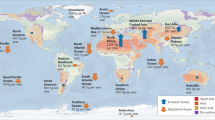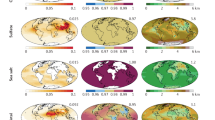Abstract
AIRBORNE mineral dust can have a significant effect on the Earth's radiation budget, as it can both scatter sunlight back to space (leading to negative radiative forcing), and absorb solar and infrared radiation (leading to positive forcing)1,2. The effects of mineral aerosols on the radiation budget are important relative to those of other types of aerosols—such as sulphate and smoke particles—due to the widespread distribution and large optical depth of mineral dust. Various human activities, such as land use practices, can result in additional loading of dust, increasing the radiative forcing. Previous studies have attempted to estimate the radiative effects of both the natural and anthropogenic components of the dust3,4. Here we use estimates of anthropogenic dust inputs and observations of dust optical properties to show that although the key quantities contributing to the evaluation of the direct solar radiative forcing by dust generated through human activities have a wide range of uncertainty, the forcing by anthropogenically generated mineral aerosols may be comparable to the forcing by other anthropogenic aerosols. On a regional scale the forcing due to mineral aerosols can greatly exceed that due to sulphate aerosols and can be comparable to that of clouds. Our analysis enables us to highlight the key quantities that need to be better characterized to reduce the (currently large) uncertainties in these estimates.
This is a preview of subscription content, access via your institution
Access options
Subscribe to this journal
Receive 51 print issues and online access
$199.00 per year
only $3.90 per issue
Buy this article
- Purchase on Springer Link
- Instant access to full article PDF
Prices may be subject to local taxes which are calculated during checkout
Similar content being viewed by others
References
Houghton, J. T. et al. (eds) Climate Change 1994: Radiative Forcing of Climate and an Evaluation of the IPCCI S92 Emission Scenarios (Cambridge Univ. Press, 1994).
Andreae, M. O. in World Survey of Climatology Vol. 16, Future Climates of the World (ed. Henderson-Sellers, A.) (Elsevier, Amsterdam, 1995).
Tegen, I. & Fung, I. J. geophys. Res. 100, 18707–18722 (1995).
Tegen, I., Lacis, A. A. & Fung, I. Nature 380, 419–422 (1996).
Charlson, R. J. et al. Tellus 43AB, 152–158 (1991).
Charlson, R. J. et al. Science 255, 423–430 (1992).
Penner, J. E., Dickinson, R. E. & O'Neill, C. A. Science 256, 1432–1433 (1992).
Chylek, P. & Wong, J. G. D. Geophys. Res. Lett. 22, 929–931 (1995).
Li, X., Maring, H., Savoie, D., Voss, K. & Prospero, J. M. Nature 380, 416–418 (1996).
Fouquart, Y., Bonnel, B., Chaoui Roquai, M. & Santer, R. J. Clim. appl. Met. 26, 28–52 (1987).
Carlson, T. N. & Benjamin, S. J. atmos. Sci. 37, 193–213 (1980).
D'Almeida, G. J. geophys. Res. 92, 3017–3026 (1987).
WMO Report of the Experts Meeting on Aerosols and their Climatic Effects (Rep. WCP-55, World Climate Program, Geneva, 1983).
Sokolik, I. N. & Golitsyn, G. S. Atmos. Envir. 27A, 2509–2517 (1993).
Ackerman, S. A. & Cox, S. K. J. geophys. Res. 87, 8991–9002 (1982).
Sagan, C., Toon, O. B. & Pollack, J. B. Science 206, 1356–1368 (1979).
United Nations Environment Programme World Atlas of Desertification (Edward Arnold, London, 1992).
Goudie, A. S. Prog. phys. Geogr. 7, 502–530 (1983).
Schutz, L. Ann. N.Y. Acad. Sci. 338, 515–532 (1980).
Duce, R. A. in Aerosol Forcing of Climate (eds Charlson, R. J. & Heintzenberg, J.) 43–72 (Wiley, New York, 1995).
Andronova, A. V. et al. lzv. Atmos. Oceanic Phys. 25, 29–36 (1989).
Penner, J. E. et al. Bull. Am. met. Soc. 75, 375–400 (1994).
Ackerman, S. A. & Chung, H. J. appl. Met. 31, 223–241 (1992).
Kiehl, J. T. & Rodhe, H. in Aerosol Forcing of Climate (eds Charlson, R. J. & Heintzenberg, J.) 281–296 (Wiley, New York, 1995).
Harrison, E. F. et al. J. geophys. Res. 95, 18687–18698 (1990).
Prospero, J. M., Uematsu, M. & Savoe, D. L. in Chemical Oceanography (eds Riley, J. P., Chester, R. & Duce, R. A.) 188–218 (Academic, London, 1989).
Westphal, D. L., Toon, O. B. & Carlson, T. N. J. atmos. Sci. 45, 2145–2166 (1988).
Tegen, I. & Fung, I. J. geophys. Res. 99, 22897–22914 (1994).
Sokolik, I. N., Andronova, A. V. & Johnson, T. C. Atmos. Envir. 27A, 2495–2502 (1993).
Atmospheric Turbudity and Precipitation Chemistry Data (WMO, US Dept of Commerce and NOAA, Asheville, NC, 1972–75)
Ben Mohamed, A. et al. J. appl. Met. 31, 1286–1293 (1992).
Panchenko, M. V. et al. Atmos. Envir. 27A, 2503–2511 (1993).
Kondratiev, K. Ya. & Zhvalev, V. F. The First GARP Global Experiment: Aerosol and Climate (in Russian) (Hydrometeoizdat, Leningrad, 1981).
Stowe, L. L. in Proc. AGU Spring Meeting May 23–27, Baltimore, Maryland (Am. Geophys. Union, 1994).
Author information
Authors and Affiliations
Rights and permissions
About this article
Cite this article
Sokolik, I., Toon, O. Direct radiative forcing by anthropogenic airborne mineral aerosols. Nature 381, 681–683 (1996). https://doi.org/10.1038/381681a0
Received:
Accepted:
Issue Date:
DOI: https://doi.org/10.1038/381681a0
This article is cited by
-
Mineral dust aerosol impacts on global climate and climate change
Nature Reviews Earth & Environment (2023)
-
Retrieving PM10 Surface Concentration from AERONET Aerosol Optical Depth: The Cairo and Delhi Megacities Case Studies
Journal of the Indian Society of Remote Sensing (2023)
-
Characteristics and a mechanism of dust weather in Northern China
Climate Dynamics (2023)
-
Seasonal Tropospheric Aerosol Classification Using AERONET Spectral Absorption Properties in African Locations
Aerosol Science and Engineering (2022)
-
Multi-year characterization of aerosol black carbon concentrations over a semiarid tropical site Udaipur
Environmental Science and Pollution Research (2021)
Comments
By submitting a comment you agree to abide by our Terms and Community Guidelines. If you find something abusive or that does not comply with our terms or guidelines please flag it as inappropriate.



